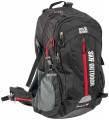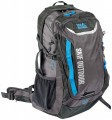—
Attachment to a suitcase. The presence of a special belt that allows you to attach the backpack to the handle of the suitcase, thereby facilitating transportation.
— Elastic cord. Elastic cord attached to the front of the backpack in special loops. The main function of this part is to carry large items that do not fit in a backpack or that need quick access. For example, using a cord, you can fix a mat, bike helmet, jacket, etc. In addition, this function can be useful for more specific tasks — for example, drying washed clothes on the go. And in some models, the cord also works as an addition to the ties: by tightening it, you can seal the backpack that is not completely filled, reducing its size and not allowing the contents to hang out inside.
—
Mount for skis. A special mount that allows you to securely fasten skis to a backpack. If you are going to use a backpack in winter, it may make sense to pay attention to the presence of this item of equipment.
— Mount for the board. A special mount that allows you to securely fasten a snowboard or skateboard to your backpack. The specific specialization should be clarified separately, however, anyway, this feature greatly simplifies the transportation of the "board" — it does not need to be carried in the hands, while the fixation is very reliable. Usually, the mount can be adjusted to the size of a particular board.
...— Helmet mount. Special fastening for a protective helmet. Most often, such a mount refers to the LidLock system, designed for bicycle and other similar helmets that have holes in the shell. The main element of LidLock is a plastic plate on an elastic strap: such a plate is threaded into the hole of the helmet “sideways”, and then installed across the hole and, due to the elasticity of the strap, keeps the helmet on the backpack.
— Loops for equipment. Loops designed to secure special equipment, for example, "ice" — ice axes or walking sticks. Most often located on the sides of the backpack and can be adjusted in size.
— Folding chair. An original function characteristic of easel-type backpacks, designed primarily for hunting and fishing. The frame of such backpacks is used for its intended purpose during transportation, and at stops you can remove the bag and unfold it, turning it into a seating device.
— USB interface. Standard USB connector located on the outside of the product. Allows you to charge smartphones, tablets and other gadgets without unpacking your backpack — the main thing is that you have the appropriate cable at hand. Of course, for such charging, you will need a power bank or other source of energy connected to the USB port from the inside; such a source is usually not included in the delivery set.
— Mini-Jack connector (3.5 mm). A standard 3.5 mm mini-jack audio jack is located on the outside of the backpack, in some models right on one of the straps. From the inside, you can connect a smartphone, media player or other similar signal source to this connector, and headphones or portable speakers from the outside. Thus, this function allows you to listen to music without getting into your backpack once again and without taking the signal source out; this is especially convenient if a large gadget such as a tablet or laptop plays the role of a playback device.
— Raincoat included. A raincoat is a waterproof cover made of thin fabric worn on a backpack as additional protection against moisture during rain or snow. It is worth noting that most backpacks are initially made of water-repellent materials that can withstand precipitation to a certain extent. Therefore, it is especially worth looking for a model with a rain cover in the kit if there is a chance during a hike to get caught in heavy rain or stay in a damp atmosphere (fog, drizzle) for a long time.
— Reflective elements. Additional inserts on the outside of the backpack, made of a special reflective material. Such elements are located at least on the straps and on the front of the product, but can also be provided from the sides. Their main function is to make a person more visible on the road at night. So, in the dipped headlights, the driver notices a pedestrian in ordinary clothes for 20-50 m (depending on the colour of the clothes), and if there are reflectors, this distance increases to 100 m or more. Thus, reflective backpacks greatly increase safety on the road; and in some countries the wearing of reflectors is even mandatory for pedestrians at night.
